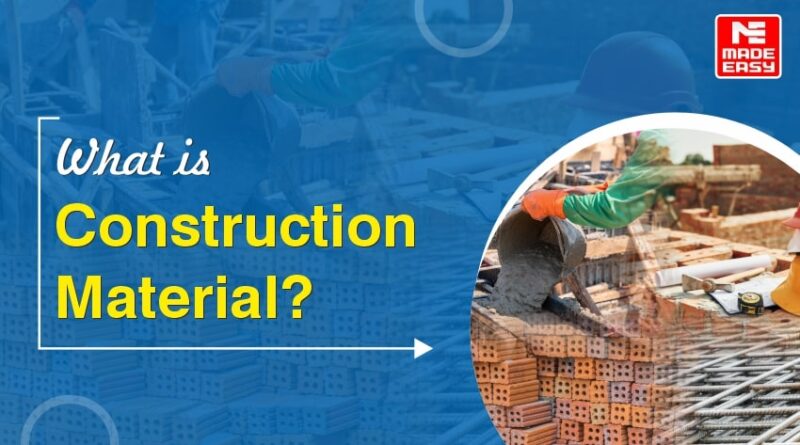What is Construction Material?
Construction plays an important role in shaping the world and the economic growth of society. Constructing roads, buildings, bridges that connect cities, skyscrapers, dams, and others is the foundation for the development of the modern world. While the development of infrastructure seems so important, understanding the properties, benefits, and limitations of various construction materials is also crucial.
Construction material refers to substances that are used in the construction of roads, buildings, dams, bridges, and developing the infrastructure. The substances are supposedly both natural and man-made. Natural substances such as clay, rocks, sand, wood, and even twigs and leaves have been used to construct buildings and other structures, like bridges. Apart from naturally occurring materials, many man-made products are in use, some more and some less synthetic. The choice of construction materials entirely depends on the project’s design, structure, durability, and environmental impact.
A thorough understanding of construction material is crucial for aspiring civil engineers. Given below are the links to the key concepts of construction material:
Key Concepts:
- Cement and Lime
- Rapid Hardening Cement (RHC)
- Soundness Test
- Good Mortar
- Maturity of Concrete
- Workability of Concrete
- Estimating Yield of Concrete
- Light Weight Concrete
- Guniting
- Brick Masonry
- Classification of Timber
- Defects due to Conversion
- Bases
- Type of Shakes
- Indian Timber Trees
- Heat Treatment of Steel
What materials are used to build a house?
Concrete, Steel, wood, stone, brick, glass, plastic, ICF blocks, Coarse aggregates, cement, ready mix concrete, binding wires, sand, clay, etc. are materials that are required to build a house. The quality of materials used in the construction determines the strength and durability of the building.
STEEL
It is the most suitable building material among all the metallic materials. Fundamentally, steel is made of iron and carbon, but many other alloying elements also get added to create thousands of different grades of steel. By suitably controlling the carbon content and other alloying elements and heat treatment, a desired combination of strength and ductility can be obtained.
On the basis of carbon content, steel is classified into following:
| Type of Steel | Carbon content (%) |
|---|---|
| Dead mild steel | <0.15 |
| Mild Steel (MS) | 0.15 – 0.3 |
| Medium carbon steel | 0.3 – 0.8 |
| High carbon steel (or hard steel) |
0.8 – 1.5 (>1% is called as cast steel or tool steel) |
Online Courses for Construction Material (CE):
Candidates pursuing civil engineering can see high competition while preparing for government engineering exams such as GATE, ESE, SSC JE and many others. While government jobs bring along a stable career and job security, it is not easier to crack the exam. Such exams expect hard work, dedication and a well strategic planning and study routine. MADE EASY is here to support your preparation journey of GATE, ESE and PSU exams. Our courses are curated by renowned experts that focus on providing quality lectures from the basic level to advanced level. MADE EASY provides aspirants the right guidance to maximize their performance and achieve success. Civil engineering candidates are advised to visit on the links given below to know more about courses that include key concepts of engineering branches taught from basic level and prepare aspirants for the future.
- GATE : 1 Year Foundation Course
- ESE+GATE : 1 Year Foundation Course
- GATE + SES (GS) : 1 Year Foundation Course
- GATE & SES (GS) 2025-26 Live Online Foundation Course
- ESE + GATE + SES (GS) 2025-26 Live Online Foundation Courses
Recommended Books for Construction Material
Books are still an essential part of learning as they offer in-depth knowledge in various topics. Learning books are well structured and provide comprehensive understanding making them invaluable for students and lifelong learners. MADE EASY Publications is one such platform for students who are looking for high quality and well structured content for their preparation. Our platform consists of government engineering exams books which are curated by a team of experts and experienced authors. Aspirants pursuing civil engineering are suggested to click on the links mentioned below to learn more in depth about construction material:
- GATE-2025: Civil Engineering Previous Year Solved Papers
- ESE 2025: Preliminary Exam: Civil Engineering Objective Solved Paper Vol-1
- A Handbook on Civil Engineering
MADE EASY faculty have briefly explained construction material and the other key concepts. Click on the given links to learn more about construction materials
- ▶️ Building Material (Part 1)
- ▶️ Building Material (Part 2)
- ▶️ Construction Materials
- ▶️ Cement | Construction Materials
Frequently Asked Questions (FAQs)
1. What are 5 examples of metals?
Ans. Iron, Steel, Aluminium, Copper, Stainless steel are examples of metals.
2. What metals are used in construction?
Ans. Steel, Copper, Aluminum, Brass, Lead, iron are some examples of metals used in construction.
3. How many types of steel are used in construction?
Ans. Structural steel, rebar steel, alloy steel, carbon steel, light gauge steel, Stainless steel, TMT bar are types of steel used in construction.
4. What is lime concrete?
Ans. Lime concrete is a composite material made from hydraulic or slaked lime, sand, and gravel. It is used in construction and has several beneficial properties.
5. What is light weight concrete?
Ans. Light weight concrete (LWC) is a type of concrete that has a lower density than regular concrete and is made by adding light weight aggregates to concrete.


